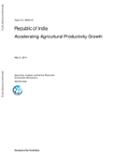Resource information
In the past 50 years, Indian agriculture has undergone a major transformation, from dependence on food aid to becoming a consistent net food exporter. The gradual reforms in the agricultural sector (following the broader macro-reforms of the early 1990s) spurred some unprecedented innovations and changes in the food sector driven by private investment. These impressive achievements must now be viewed in light of the policy and investment imperatives that lie ahead. Agricultural growth has improved in recent years (averaging about 3.5 percent since 2004-05), but at a long-term trend rate of growth of 3 percent, agriculture has underperformed relative to its potential. The pockets of post-reform dynamism that have emerged evidently have not reached a sufficiently large scale to influence the sector's performance. For the vast population that still derives a living directly or indirectly from agriculture, achieving "faster, more inclusive, and sustainable growth', the objectives at the heart of the Twelfth five year plan, depends critically on simultaneous efforts to improve agriculture's performance and develop new sources of employment for the disproportionately large share of the labor force still on the farm. The scope of this study is broad in the sense that it marshals considerable empirical evidence and analyses to address those issues. Yet the scope is restricted in the sense that the study does not address all of the issues. A wealth of knowledge exists (and continuing analytical work proceeds) on other major strategic issues, water and irrigation management, food grain management, and public expenditures on agriculture, for example, and the findings of this study must be seen in that context. The lack of sufficient quality data, and often the lack of access to such data, also prevents some issues from being explored in greater depth. Finally, some important issues require more focused and dedicated analysis, such as food safety and quality standards, agricultural trade, and food price increases. This relationship between longer-term strategic issues and contemporary concerns, such as water resource management and food prices, are highlighted in this study through the prism of productivity, but they too require further analysis to fully address the underlying issues.


